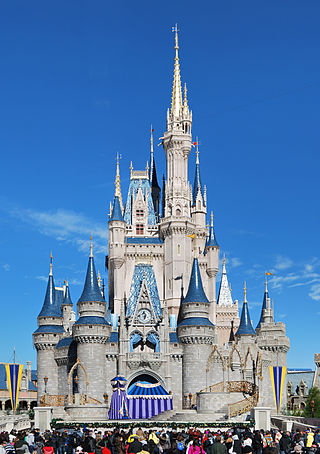
An amusement park is a park that features various attractions, such as rides and games, as well as other events for entertainment purposes. A theme park is a type of amusement park that bases its structures and attractions around a central theme, often featuring multiple areas with different themes. Unlike temporary and mobile funfairs and carnivals, amusement parks are stationary and built for long-lasting operation. They are more elaborate than city parks and playgrounds, usually providing attractions that cater to a variety of age groups. While amusement parks often contain themed areas, theme parks place a heavier focus with more intricately-designed themes that revolve around a particular subject or group of subjects.

Coney Island is a peninsular neighborhood and entertainment area in the southwestern section of the New York City borough of Brooklyn. The neighborhood is bounded by Brighton Beach to its east, Lower New York Bay to the south and west, and Gravesend to the north and includes the subsection of Sea Gate on its west. More broadly, the Coney Island peninsula consists of Coney Island proper, Brighton Beach, and Manhattan Beach. This was formerly the westernmost of the Outer Barrier islands on the southern shore of Long Island, but in the early 20th century it became a peninsula, connected to the rest of Long Island by land fill.
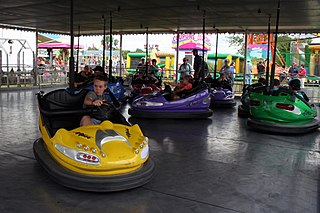
Bumper cars or dodgems are the generic names for a type of flat amusement ride consisting of multiple small electrically powered cars which draw power from the floor or ceiling, and which are turned on and off remotely by an operator. They are also known as bumping cars, dodging cars and dashing cars. The first patent for them was filed in 1921.

In the United States, trolley parks, which started in the 19th century, were picnic and recreation areas along or at the ends of streetcar lines in most of the larger cities. These were precursors to amusement parks. Trolley parks were often created by the streetcar companies to give people a reason to use their services on weekends.

Luna Park was an amusement park in Coney Island, Brooklyn, New York City. The park was located on a site bounded by Surf Avenue to the south, West 8th Street to the east, Neptune Avenue to the north, and West 12th Street to the west. Luna Park opened in 1903 and operated until 1944. It was located partly on the grounds of the small park it replaced, Sea Lion Park, which operated between 1895 and 1902. It was the second of the three original, very large, iconic parks built on Coney Island; the others were Steeplechase Park and Dreamland. At Coney Island's peak in the middle of the 20th century's first decade, the three amusement parks competed with each other and with many independent amusements.

Steeplechase Park was a 15-acre (6.1 ha) amusement park in Coney Island, Brooklyn, New York City. Steeplechase Park was created by entrepreneur George C. Tilyou in 1897 and operated until 1964. It was the first of the three large amusement parks built on Coney Island, the other two being Luna Park (1903) and Dreamland (1904). Of the three, Steeplechase was the longest-lasting, running for 67 years.
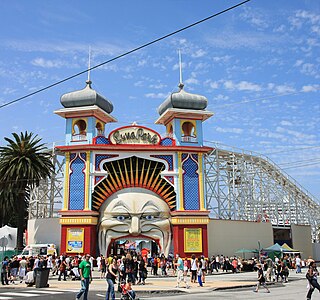
Luna Park Melbourne is a historic amusement park located on the foreshore of Port Phillip Bay in St Kilda, Melbourne, Victoria. It opened on 13 December 1912, with a formal opening a week later, and has been operating almost continuously ever since.

Virginia Reel was an older style of spinning roller coaster characterized by spinning circular "tubs" that zig-zagged down a flat-bottomed track.

The Cyclone, also called the Coney Island Cyclone, is a wooden roller coaster at Luna Park in Coney Island, Brooklyn, New York City. Designed by Vernon Keenan, it opened to the public on June 26, 1927. The roller coaster is on a plot of land at the intersection of Surf Avenue and West 10th Street. The Cyclone reaches a maximum speed of 60 miles per hour (97 km/h) and has a total track length of 2,640 feet (800 m), with a maximum height of 85 feet (26 m).
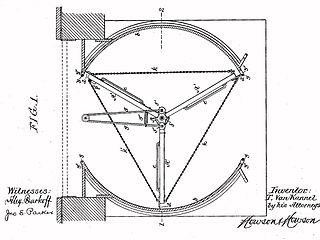
Theophilus Van Kannel was an American inventor, known for inventing the revolving door, patented on August 7, 1888.

The Rotor is an amusement ride designed and patented by German engineer Ernst Hoffmeister in 1948. The ride was first demonstrated at Oktoberfest 1949 and still appears in numerous amusement parks. The Rotor is a large, upright barrel, rotated to create an inward acting centripetal force supplied by the wall's support's force. Once at full speed, the floor is retracted, leaving the riders stuck to the wall of the drum.
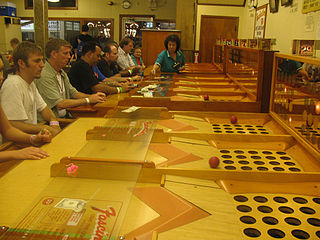
Fascination is a game commonly found in North American amusement parks, boardwalks and arcades. The game is a redemption game, in that prizes are often won for playing the game. The game dates to 1918, with the first location opening at Coney Island, NY. It became popular during the 1920s and spread quickly from coast to coast, as evidenced in pictures of Chutes at the Beach in San Francisco, a park that operated from 1903 - 1928. Over a century later, there are still a handful of locations that are in operation, mostly in the Northeastern US.
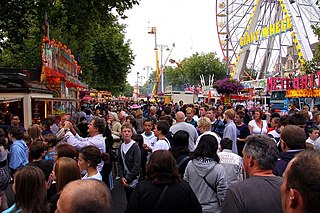
St Giles' Fair is an annual fair held in St Giles', a wide thoroughfare in central north Oxford, England. The origins of the fair can be traced back to medieval times where it became one of England's dynamic trading centers. The fair has survived medieval times and is organised for a two-day duration in September each year by the Oxford City Council with the London and Home Counties section of the Showmen's Guild of Great Britain.

The Whip was a ride originally designed and built by W.F. Mangels Company of Coney Island, New York, United States. William F. Mangels patented the ride in 1914 and it soon became extremely popular.

Astroland was a 3.1-acre (1.3 ha) amusement park in Coney Island, Brooklyn, New York City that first opened in 1962. It was located at 1000 Surf Avenue on the boardwalk. It ceased operations on September 7, 2008.

Charles I. D. Looff was a Danish master carver and builder of hand-carved carousels and amusement rides, who immigrated to the United States of America in 1870. Looff built the first carousel at Coney Island in 1876. During his lifetime, he built over 40 carousels, several amusements parks, numerous roller coasters and Ferris wheels, and built California's famous Santa Monica Pier. He became famous for creating the unique Coney Island style of carousel carving.
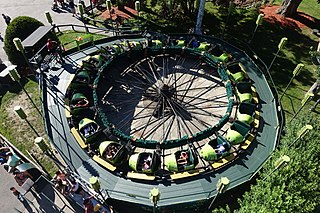
The Caterpillar ride is a vintage flat ride engineered by the inventor Hyla F. Maynes of North Tonawanda, New York, who dubbed it the Caterpillar when it debuted in Coney Island, New York in 1925. It generates a significant amount of centrifugal force, causing the riders on the inside of the seats to crush the riders on the outside of the seats. It was once found at nearly every amusement park around the United States, but is now so rare that an original Caterpillar ride can only be found operating in two parks today. Though only two Caterpillars are known to be operating, there have been reports claiming there are additional Caterpillars in storage or standing at a few other parks.

Luna Park is an amusement park in Coney Island, Brooklyn, New York City. It opened on May 29, 2010, at the site of Astroland, an amusement park that had been in operation from 1962 to 2008, and Dreamland, which operated at the same site for the 2009 season. It was named after the original 1903 Luna Park which operated until 1944 on a site just north of the current park's 1000 Surf Avenue location.

Frederic Williams Thompson was an American architect, engineer, inventor, and showman known for creating amusement rides and one of the first large amusement parks.





















